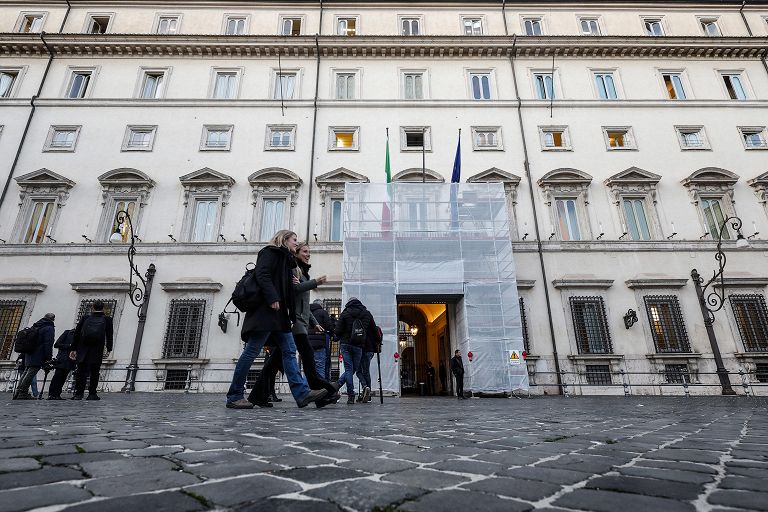The square isn’t there, it wasn’t found. At the moment the unions – Cgil Cisl and Uil – They emerge from the confrontation with the government with a no to the tax reform system, a negative opinion both on the merits and “in the method of confrontation” as the executive branch prepares to introduce the enabling law – Thursday – in the Council of Ministers and continues the round of meetings with the social partners that started yesterday with the Confederates with the business and professional associations and professional associations scheduled for today.
Palazzo Chigi, Government Union Meeting on Tax Reform. The Deputy Minister of Economy and Finance Leo and the Secretary of State of the Presidency of the Council of Mantua
Sore points of the Palazzo-Chigi meeting, complains the “Description of the Enabling Act, 48 Hours from the Council of Ministers”. CGILwho also does not agree on the merits of the reform: “We do not agree on either of them Lowering of the three rates because it favors high and very high incomes – said the deputy secretary general of the CGIL, Gianna Fracassi – even further Flat tax that falls outside the progressive dimension provided for by the Constitution“.

“Insufficient“, confrontation with the government, also for the Cisl, according to which there is a need to “accelerate the comparison of social security, pensions, health and safety, non-self-sufficiency, investment recovery, quality and stability of work”. That’s how Luigi Sbarra says he’s ready to rate, along with the other acronyms “mobilization initiatives“.
 handle
handle Picture Archive Agency of Revenue
“This delegation must deal with a as a matter of priority epochal turning point in the fight against tax evasion, a real fight without which there can be no real tax reformhe says Uiladdressing the merits of the reformulation of the three rates of income tax, says that the Executive “it does not provide an answer to the need to shorten the control wedgewhich we now have to cut by 5 points, not during the legislature,” said Federal Secretary Domenico Proietti.
 (handle)
(handle) Exterior view of the Palazzo Chigi
The government’s note after the meeting
“The representatives of the executive gave assurances to the trade unions present maximum openness to dialogue and confrontation throughout the parliamentary process Authorization of the delegation and subsequent implementation measures”, the press release, in a note from Palazzo Chigi after the meeting with CGIL CISL UIL, “underlines the government’s willingness to arrive at the most concrete and common reform”. Does the government reiterate the intention of the reform, which aims to “Simplify obligations, promote cooperation with tax authorities and promote capital return“.
 (pixabay)
(pixabay) financial management
The “revolution after 50 years”
The draft law that was the subject of the meeting represents a “revolution”, according to the government, 50 years after the last major reform, which dates back to the 1970s. Summarized in the provision it will go from 4 to 3 personal income tax bracketsa gradual one Elimination of IrapThe Irish in two installments, A VAT reorganization. But the provision also includes a review of tax breaks, a reduction in disputes between the administration and taxpayers, and “attracting foreign capital.” These are the main innovations of the Meloni government’s tax reform, which will arrive at the Council of Ministers on Thursday.
 (Contrast)
(Contrast) Ministry of Economy and Finance
The “flat tax” within the legislature
The aim of the legislature is the flat tax for everyone, which can be achieved by expanding the so-called “level flat tax”. Employees.
 (pixabay)
(pixabay) Work
The new income tax brackets
Two are the assumptions: 23%, 27% and 43%. Or 23%, 33% and 43%. The funds will come at least in part from the review of the concessions, with a “expired on an income basis”, which – according to the government – leaves those for mortgages and health care costs intact. two Ires installmentswith a cut to income earmarked for investment and new employment that will match Streamline or abolish existing tax credits.
 handle
handle Confindustria headquarters logo
One of the other measures – which companies are already advancing with flying colors – is the gradual overcoming of Irap (starting from small businesses), shared by everyone. Traders and consumers, on the other hand, are primarily looking at the reorganization of the VAT rates. The delegation is not explicit as to its composition, but Deputy Economy Minister Maurizio Leo spoke of the possibility of a zero rate (as was the case with the Covid vaccines). bread, pasta or milk. Another goal is the abolition of the stamp duty – mortgage and cadastre – but also the special cadastral taxes and mortgage taxes, which are “possibly at a fixed amount” are to be replaced.
 Photo by 1195798 from Pixabay
Photo by 1195798 from Pixabay Bread
Collections: 120 installments
In debt collection, the goal is to gradually overcome the role and simplified access to means of payment in 120 installments. In the event of non-payment, the contractual penalties will be reviewed not repeated and more appropriate to the behavior complained of.
 (handle)
(handle) Exterior view of the Palazzo Chigi
The position of the unions comes on the eve Congress of the CGIL, which opens today in Rimini, where Prime Minister Giorgia Meloni will also speak on the stage on Friday. The wait is for his intervention.